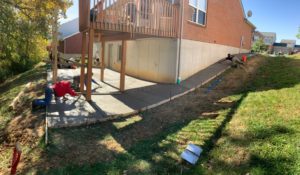
What causes concrete to crack? There are a number of reasons why concrete cracks. The most common is because concrete shrinks as the excess water evaporates and it hardens. Unfortunately, too often contractors add too much water to the mix, which makes it easier to apply but also more vulnerable to cracking. Cracks can also result from a poorly planned foundation, improper finishing, or even form curing the concrete. The following are examples of a couple of the more common causes…
- Crazing Cracks – Crazing in concrete is the development of a network of fine random cracks or fissures on the surface of concrete caused by shrinkage of the surface layer. These cracks are rarely more than 3mm deep, and are more noticeable on over floated or steel-troweled surfaces. They can be prevented either through immediate curing or else by dampening the base prior to pouring the concrete, thereby reducing the amount of water it will absorb from the concrete and forcing it back up to the surface.
- Shrinkage Cracks – Shrinkage cracks in concrete occur due to change in the moisture of concrete. Concrete and mortar are porous in their structure in the form of inter-molecular space. They expand when they absorb the moisture and shrink when they dry. This is the main cause of concrete shrinkage cracks on drying. They cause the surface of the concrete to dry faster than the excess water can seep up to keep it moist, resulting in shrinkage of the concrete and therefore, cracks.
How To Prevent Cracks From Forming
Most cracks that form during the construction process can be minimized.
- Start with a sound subgrade. Make sure the subgrade is compacted.
- Modify the concrete mix. Use a low water-to-cement ratio.
- Install the joints. Be active where control joints will be placed.
- Properly cure the concrete.
- Isolate joints separating the concrete from an object such as a drain.
Concrete vs Cement?
Cement is an ingredient used to make concrete. The cement is what reacts to the water in the mix and become the glue of the cement, holding it together and making it strong.
Is There a Way to Reinforce Concrete?
The solution is to put reinforced concrete permanently into compression by prestressing it (also called pretensioning). Use rebar for structural reinforcement. Place the rebar vertically and horizontally in 4-foot sections creating a grid pattern. Or using fiber mesh or wire mesh preventing cracks from forming. Fibers are much more lightweight and tend to stay in position better. Fiber mesh tends to be less expensive and requires far less labor to install. By using the rebar and the fiber mesh you build an effective support system to reinforce your concrete project
How Does the Weather Affect When Concrete Can Be Poured?
Concrete that freezes at an early age can lose much of its overall strength. Done properly, concrete poured in cool weather is actually stronger than concrete poured in hot weather, thanks to the slow curing period. When outdoor temperatures are below 20 degrees Fahrenheit, it is best to simply abandon the idea of pouring concrete. Admixers such as water reducers or accelerators can be added to concrete to combat potential issues. With those additions, the only times’ that are not recommended are when it is raining or freezing temperatures.
How Much Concrete to Use?
Measure the length and width that you’d like to cover. Multiply the length by the width to determine the square footage. Convert the thickness from inches to feet. Multiply the thickness in feet by the square footage to determine the amount of concrete you will need to order in cubic yards, the standard measurement by which contractor order concrete.
What Kind of Concrete to Use?
The strength of concrete is measured in pounds per square inch (PSI) and is a measurement of the concrete’s ability to carry loads or handle compression. The higher the number, the stronger the concrete. For example, most contractors use between 3000 PSI and 5000 PSI for residential applications such as driveways and garage floors. That would make the concrete to hold firm underneath more than 3000 to 5000 pounds.
How Long Until You Can Drive on New Concrete?
To allow the concrete ample time to strengthen and harden, we recommend waiting between 10 and 14 days to use concrete driveways on garage floors.
Can I Pour Concrete Myself?
Although it may be tempting to roll up your sleeves, mix up some concrete, and tackle a concrete project yourself to save money, you will likely spend most of your time preparing for the project. From planning a complete and realistic budget to considering help from professional concrete contractors for certain steps of the project to making sure your project is allowed by the local permitting office, there’s a lot to do before you start mixing up that gray matter! Pouring and finishing concrete is hard work, and often the convenience of hiring a contractor outweighs the enticement of a challenge for most homeowners.
Can I Use Chemical De-icers on Concrete?
Although concrete is an extremely durable product, the following care and maintenance guidelines will add to the value of your investment: Do not apply deicing chemicals for snow and ice removal during the winter. To provide traction, sand is recommended. If absolutely necessary we suggest using magnesium or potassium-based deicer. They are less damaging to the concrete. However, keeping the snow away by shoveling is the best suggestion.
Can I Make Concrete Look More Appealing?
There are many options for upgrading concrete. Add color directly into the concrete mix. Stamp the concrete to look like brick or stone. Stamp the concrete is not only pleasing to the eye it also helps disguise any future flaws form being quite as noticeable.
—
Presentable Landscaping Concrete Services
Concrete repair, replacement, and installation services. We specialize on helping customers with driveways, sidewalks, patios, pool decks, and retaining walls. If it’s outside and you need concrete then we can almost always help you. We can help you with a variety of finishes, textures, and colors. > Learn More / View Past Work
Contact us (859-640-0657) for a free consultation!
—
 About Presentable Landscaping
About Presentable Landscaping
Presentable Landscaping provides many landscaping services to our customers in Northern Kentucky and Greater Cincinnati.

 About Presentable Landscaping
About Presentable Landscaping